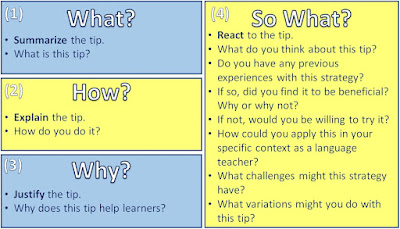Diseño de Materiales - Week 5 - Principles of Effective Materials Development
Introduction: Hello and welcome to Week 5 of the course Diseño de Materiales for the Licenciatura in English Teaching at ULACIT. In this class we will discuss your analysis of several published checklists and review key concepts from a reading about deriving criteria for materials evaluation development from principles of second language acquisition and teaching.
- Discuss important considerations for the creation of a checklist or rubric for materials evaluation.
- Explore Tomlinson's principled approach to materials design by matching SLA and teaching-learning principles with criteria for materials development and use.
- Share your univeral criteria based on your own principles of language teaching and learning and evaluate whether they meet the characteristics of effective criteria.
Guiding Questions:
- What are the features of a good checklist?
- What criteria can I propose to evaluate ELT materials?
- How can SLA research inform my practice as a materials designer.
- What are my personal principles of materials design?
Task 1: My Criteria
For our warm up activity you will propose your own criteria for a lazy rainy day, a great vacation, a perfect pizza, or any other non-academic product or experience. Be ready to share your essential criteria with the class.Click the link and find your section of the document.
- Group Checklist: CLICK HERE
There are many ways to make an evaluation checklist or rubric. Let's start by analyzing some published checklists (Jusuf, 2018) to see what they offer, how they are organized, and determine their relative strengths and weaknesses. Click the link below and go to your group's section of the document.
- ELT Textbook Evaluation Checklist Evaluation Checklist: CLICK HERE
Task 3: Cataloguing Our Criteria
For homework you read Chapter 1: Materials Evaluation in Tomlinson (2013) and learned his technique for generating lists of universal criteria by first articulating your beliefs about language learning (backed by sound SLA and learning theory) and using them as categories to define criteria that materials should fulfill. You already articulated 5 of your core beliefs and 2-3 universal criteria based on on them. Now you will share and compare your criteria with your peers.
Add three of your beliefs and their corresponding criteria in your section of the document below. Then read though the entire list with your partners and decide if each criterion:
- Avoids ambiguous terminology
- Addresses only one feature at a time
- Group Document: CLICK HERE
In chapter 4 of Harwood (2010), Brian Tomlinson argues in favor of a principled approach to materials development by first identifying principles from second language acquisition research as well as principles about teaching-learning in general in order and then using those as categories to generate materials for materials development. Click your group link below and follow the instructions in the document.
- Group 1: CLICK HERE
- Group 2: CLICK HERE
- Group 3: CLICK HERE
References:
Harwood, N. (Ed.). (2010). English Langauge Teaching Materials: Theory and Practice. Cambridge University Press.
McGrath, I. (2016). Materials Evaluation and Design for Language Teaching (2nd ed.). Edinburgh University Press.
Tomlinson, B. (Ed.). (2013). Developing Materials for Language Teaching (2nd ed.). Bloosmbury Academic.









































